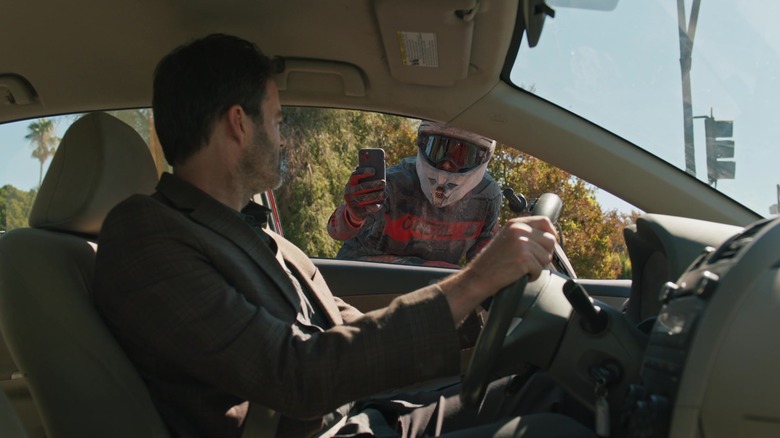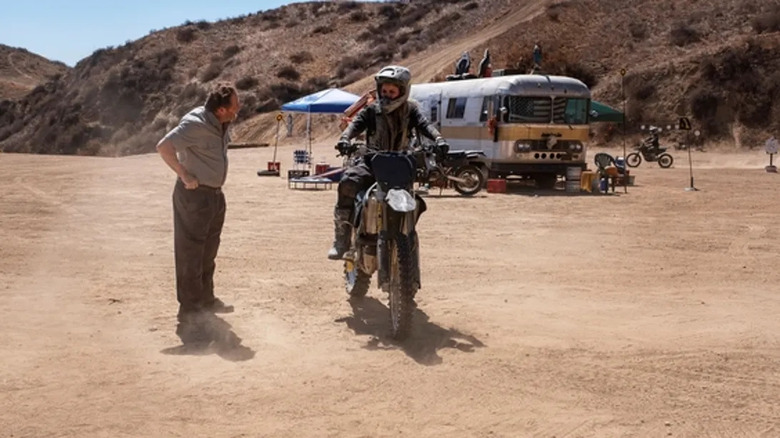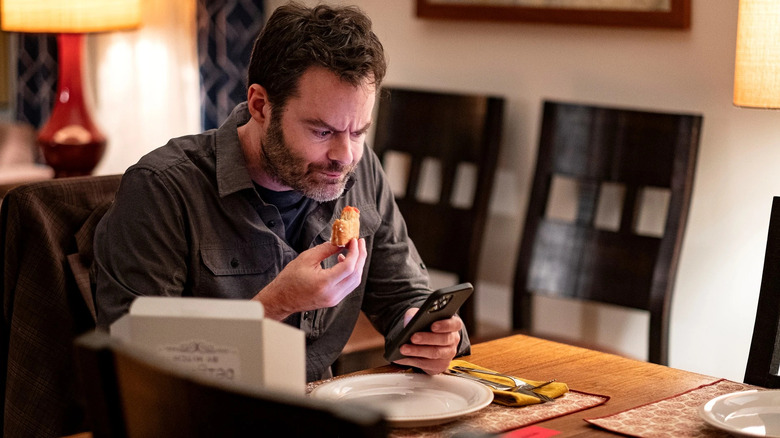Barry Cinematographer Carl Herse On Crafting That Wild Chase Sequence In Last Night's Episode [Interview]
"Barry" just hit a high note. In episode six of season 3, "710N," there's a thrilling chase scene. Without fast cutting or obtrusive music, director Bill Hader uses silence, space, and distance to create an intense combination of action and dread. As Hader's character heads to a reunion with some old veteran pals, he's targeted by a dirt bike gang who are out for revenge, and the dirt bikes are almost like a manifestation of Barry's past sins chasing after him as he continues to try to outrun his past. The whole sequence is a perfect meeting between character and spectacle.
Cinematographer Carl Herse shot the episode. As challenging as that killer sequence looks, as he told us, shooting it went rather smoothly. The cinematographer, who previously worked on "The Afterparty," recently told us about working on the episode and the crime films that continue to influence "Barry."
This interview has been lightly edited for clarity and brevity.
'Bizarrely quiet and calm'
The space and distance creates such suspense during the chase.
Yeah, absolutely. That's something that I think Bill, he really doesn't want to romanticize it or make it seem too cool. Barry, he has all these skills as an ex-military person, but he's also just a guy. And so, when he's riding a motorcycle, we don't have to make him seem like a superhero, he's just on a motorcycle. Now, he's lane splitting. And just the act of lane splitting is dynamic enough for our world that it feels interesting. I think another thing that our show likes to do is show that these characters are inhabiting their world and that there's a world around them.
In the opening of this season, in episode 2, we see Barry go out to the trunk of his car where Cousineau is, but a lot of that plays out with a woman in the foreground staring at her laptop. If she looked to her left, she'd be seeing this ridiculous situation happening, but they're always just right outside the periphery of the real world. In episode 2, there's also a scene with the woman on her phone talking about a bad date she went on and suddenly there are a bunch of Bolivian mercenaries crossing in front of her.
In that chase sequence, they did some very interesting things with sound design, where our shot isn't super dynamic while we're lane splitting, but you hear every car's radio going by as they whizz through the traffic. I think that's a very interesting way of making the stakes feel relatively high, but also it gives the show this off-kilter weirdness that I think makes it very unique.
There are so many moving pieces to the chase. Where does your work start there?
Well, it starts with us all sitting around a big table and talking through what is important about the story and what we're trying to tell. Bill expresses shots that are in his head and we work with a pre-visualization animation studio that basically creates an animation of the entire sequence. I remember the first time we all sat down together and watched the final approved version — because there are several versions — but we've got the producers, the [assistant director], myself, the production designer, and we watched this animated version of the chase.
It's just so interesting and kind of bizarrely quiet and calm in a way that makes the final beat of the guy just crashing at the end so funny, the entire room just exploded with laughter. And that was just in an animation — that wasn't even our version of it. But knowing the sequence works so well at that stage makes everyone feel confident to do it.
It seems overwhelming when you look at it in real time, but once you start breaking down the shots, it becomes manageable. We were really lucky to have an incredible producer, Aida Rogers, who was able to provide what we needed to get the work done. We brought some of the best people in the business together to shoot motorcycle work, which is exceedingly complicated, especially on a highway.
So much of it was really the AD and I sitting down with storyboards and just looking at, basically, the sun position and come up with a plan for the order that we can shoot in based on the equipment we're using, where I want the sun to be, what the limitations are with using pyrotechnics like gunfire and stunt work like motorcycles crashing or cars crashing.
You just break it down to the elements. On the day, it moves relatively quickly. I mean, a film set is always slower than you think it will be, but each day was achievable in the schedule. Bill is so good at just shooting exactly what he needs and he doesn't shoot anything other than that. It's interesting that he doesn't offer himself too many get out of jail cards in case something isn't working, but strangely it always seemed to work.
'The consequences are here now and you can't escape them'
Bill Hader is a big fan of Jean-Pierre Melville, Kurosawa's crime movies, and films like "Mona Lisa" and "The Hit."
Hundred percent.
A lot of those movies, like "Barry," use silence and distance to create suspense. Were those the movies you two talked about?
Definitely. Kurosawa was a big one. "Throne of Blood," in particular, was one that we talked about a lot. There's actually a direct reference to "Throne of Blood" where the woman goes to get the poison wine and disappears into darkness and Bill, we were in the middle of lighting that, and he was trying to describe what he was wanting and we were trying different lighting effects and stuff. And then he was just like, "You know the shot in 'Throne of Blood'?" And I was like, "Oh, okay. Yeah. Great." And so then suddenly it was like, in a moment we were, "Yeah, okay, we're right."
I think you can see a bit of that movie's influence in even the ending of the latest episode, just how chaotic it goes.
Yes. And that's the theme of the season. I think it is really that moment of, you reap what you sow, you can't escape what you've written up until this point. I think a lot of TV shows do have a similar way of writing themselves and having to double down, but "Barry" really tries not to wiggle out of situations. It leans into them and is like, "Okay, well, we've written this thing. Now, what would really happen, honestly? And how do we make it work, and how does it remain compelling and also real?" And in that way, the story, what started as — the original setup was a little sillier than I think where the show is now, but this is just the course we've been on and it's going to get progressively less silly and more serious. The consequences are here now and you can't escape them.
"Barry" season 3 is now airing on HBO.


